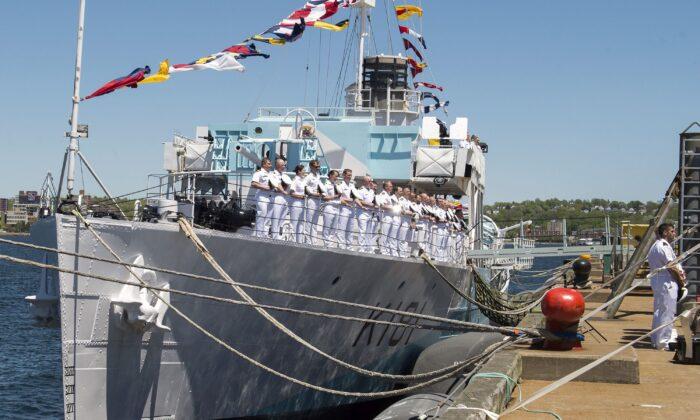Canada is ready aye ready for naval combat. In 2033. And for carving the pork starting yesterday. So says DND, our sad acronym for a Department of Defence that doesn’t have a cool polygonal HQ. Or much of anything else.
Like sidearms. Or ships. Or soldiers. Or even diversity; recently DND tweeted a photo of their commitment to inclusion showing eight white guys eight north of 40. Oops.
At least the navy has money or thinks it does. Some $60 billion for these ships and counting instead of the original $26 billion, a tidy reward for not delivering on time. They even added some smaller ships to give Irving Shipbuilding something to do until it built the bigger ships.
Complexity being the first refuge of a scoundrel, we’re told it’s because warships are complicated, especially in the 21st century. Even if it’s an existing “Type 26” design also being built in the UK and Australia, though “built” is just this word, unlike “industrial policy,” that puts buying regional votes ahead of whatever that thing is the pointy-heads go on about. Oh yeah. Security.
Thus, we also just learned that the Canadian government is shovelling money and high-tech secrets at Huawei via NSERC, the National Sciences and Engineering Research Council. Apparently nothing, including Chinese cyber-soldiers marching up to the Peace Tower, would worry these people. Which I mention because another major issue here is technology moving faster and faster while our procurement process does the opposite.
So permit me here to summon the shade of HMS Dreadnought. Well, one of 11 vessels of that name anyway. Specifically, the 1906 wonder of the steam age boasting 23,000 horsepower cranking out 21 knots, a monster that instantly and ominously rendered all existing navies obsolete. Including her own, opening the door to a German lunge to rule the waves and sink Britannia on Der Tag.
Alas, in the modern world, technology moves fast and all that is solid melts into air. By the time of the only major surface fleet clash of World War I off Jutland just a decade later, in 1916, Dreadnought was already obsolete and by 1921 was sold for scrap. Before TV or radios, let alone PCs and iPhones. Imagine the urgency of keeping your weapons up to date now.
Not in Canada. Vice-Admiral Craig Baines, commanding the quaint regional museum called our navy, burbled “When you put ships in saltwater over time, there’s going to be an effect,” which one hopes wasn’t news. But “based on all our estimates on the conditions of the ships, we’re very comfortable that we’ll be able to transition with this plan,” which one hopes wasn’t believed. And may not have been understood. Transition to what? Which plan?
Perhaps to make our enemies die laughing. The CP story went on to make an even more ludicrous statement with no fanfare, calling this report “the latest setback for the new fleet of warships, which … are expected to serve as the Navy’s backbone for the better part of the century.”
Ahem. I have a telegram from Dreadnought here warning that governments, despite being as gung ho about artificial intelligence as they are blithe about Chinese espionage, haven’t realized that long before we had even rotary phones, you couldn’t deploy a ship in 1840 (specifically HMS Nemesis, launched by the East India Company in 1839 as the first British ocean-going iron warship and the terror of the First Opium War, boasting twin 60 hp engines) and still rely on it in 1891 (Royal Sovereign, launched that year, had 11,000 hp and could hit 17 knots).
You certainly can’t deploy a ship in 2040 and still rely on it in 2091. As if we would. Launch in 2040, I mean. Instead, the story added, we’ll probably need to keep some of our early 1990s Halifax-class frigates going into the 2040s.
So imagine Royal Sovereign firing brown powder at Dunkirk. (Mind you the Royal Navy did use Swordfish biplanes to help sink the Bismarck; democracies are often careless about national security.) Or, since the Halifaxes resulted from a 1970s procurement project, imagine fighting Hitler and Hirohito with ships designed under Disraeli. Specifically the Devastation class, with 6,000 coal horsepower, 13 knots, and iron-plated teak or oak, though at least they dispensed with sails.
Now stand by for a thunderous barrage of rhetoric and broadside of pork from the fleet of the future. The distant future.






Friends Read Free